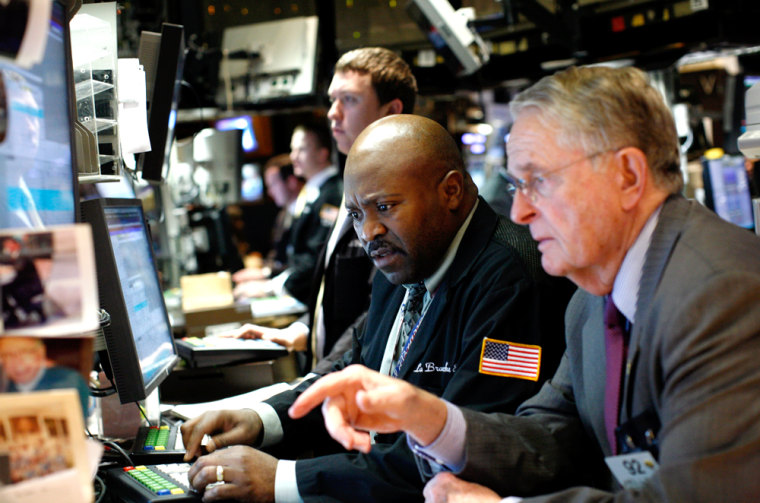There was a time when thresholds meant something. The Dow Jones average sinking below 8,000 must mean the bottom is near. The S&P 500 falling 50 percent from its high must signal the end of the free-fall.
Economists, money managers and traders who watch the markets closely say you can't assume previous bear market measures mean much. They acknowledge they don't know where the bottom is and anxiety remains high. So does the selling, which continued Thursday.
Stocks plunged to levels not seen in more than five years. Huge declines in the financial and energy sectors led stocks lower for the second straight day.
The Standard & Poor's 500 index closed down 6.7 percent to 752.44, below the closing low of 776.76 logged on Oct. 9, 2002.
The Dow Jones industrial average fell about 445 points, or 5.6 percent.
"The thresholds are irrelevant. We just blow right through them," said Diane Swonk, chief economist with Mesirow Financial Holdings Inc., a Chicago-based investment firm.
She said any confidence that had come back from news of a government financial services bailout and lower interest rates seems to have evaporated as Bush administration officials now say they'll hand off much of the bailout responsibilities to the incoming Obama administration.
"It's very difficult for individuals and financial markets particularly to shake off the fear when basically Washington is on hold in the middle of a crisis," she said.
Randy Frederick, director of derivatives at the Charles Schwab Center for Financial Research said there's no sure way to tell when the market hits bottom, but if history is any guide, we're likely near the end of the down cycle. The average bear market — a prolonged decline in the stock market of 20 percent or more — lasts about 13 months and the current cycle began in October 2007.
Still history would also suggest improvement in the broader economy will take longer. Average recessions last 10 to 11 months and many believe the current one started in January, he said.
"Once we bottom out on the markets and actually start to go higher, which it doesn't look like we've done yet, the economy still could have another three to eight months more to go before it digs out," he said.
Eric Cinnamond, who manages a small cap fund for Intrepid Capital Funds in Jacksonville, Fla., said it's unclear how much more selling will occur before investors jump back in, but it is clear that much of the sell-off now seems to be attributable to forced liquidation.
Mutual funds have seen extensive redemptions and must sell assets to raise cash to pay investors.
"We're clearly in some sort of liquidation phase," he said. "It's broad mass liquidation. It's selling regardless of value, regardless of net worth."
The Investment Company Institute said the nation's mutual funds decreased by $959.3 billion, or 8.3 percent, in September to $10.6 trillion.
The same has happened with hedge funds, which have been aggressively selling since September to pay investors who want out.
The Vanguard Group Inc. chief investment officer, Gus Sauter, said there are signs to watch for that may indicate a turnaround.
He said the first sign investor confidence has returned could come when 3-month Treasury bill yields begin moving upward. Currently they're at 0.1 percent. He said he'd like to see the yield get to at least 0.5 percent to 0.75.
The low yield is an indication investors lack confidence in equities and are putting their money in the safety of government instruments.
A restoration of confidence could lead to more bargain hunters getting back in the market. Very low stock valuations encourage those with cash and the courage to stomach volatility to search for good buys.
"Look for companies that are leaders in their industry, companies you know will be here a few years from now," said Schwab's Frederick.
He says companies like Microsoft Corp., Hewlett-Packard Co. and The Procter & Gamble Co. will be here and are on sale.
(Msnbc.com is a joint venture of Microsoft and NBC Universal.)
He suggests buying small batches of stocks so that if the market drops further you don't lose significantly and if it goes up, you can always buy more.
Sauter said anyone who gets in the market now will look back 10 years from now and be glad they did.
"Recognize the market could go lower and if you're not comfortable with the market going lower you'd better be careful," he said. "If you have a long time horizon, if your 30 years-old look at this as a real gift. Even if you're 40 or 50, if you're going to be working 10 more years, you're perhaps buying the opportunity of a lifetime."
Sauter's sentiments were echoed by Cinnamond. "You should stick with companies that are going to survive and pick up market share," he said. "Somebody's going to make it. The whole country's not going into bankruptcy."
